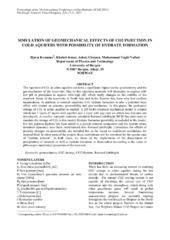Simulation of geomechanical effects of CO2 injection in cold aquifers with possibility of hydrate formation
Chapter, Peer reviewed
Published version
Permanent lenke
https://hdl.handle.net/1956/8047Utgivelsesdato
2011Metadata
Vis full innførselSamlinger
Originalversjon
In: Proceedings of the 7th International Conference on Gas Hydrates (ICGH 2011), Edinburgh, Scotland, United Kingdom, July 17-21, 2011Sammendrag
The injection of CO2 in saline aquifers can have a significant impact on the geochemistry and the geo-mechanics of the reservoirs. Due to this injection, minerals will dissociate in regions with low pH or precipitate in regions with high pH, which imply changes on the stability of the reservoir. Some of the reservoirs in North Sea, and in the Barents Sea, have very low seafloor temperatures. In addition to mineral reactions, CO2 hydrate formation is also a potential local effect with impact on porosity, permeability and geo-mechanics. In this paper, the geological storage of CO2 in saline aquifers is studied. A 2D hydro-chemical mechanical model is created which has 3 layers (2 layers with aquifers and 1 layer with cap rock on which two fractures are introduced). A reactive transport reservoir simulator RetrasoCodeBright (RCB) has been used to simulate the storage of CO2 in this model. Hydrate formation possibility is included in the model. For this purpose hydrate has been added as a pseudo-mineral component and the hydrate phase transition dynamics have been implemented into RetrasoCodeBright. Corrections for effects of porosity changes on permeability are included but so far based on traditional correlations for mineral/fluid. In other parts of the project, these correlations will be reworked for the special case of "hydrate mineral". In both cases, we focus on the implications of the dissociation or precipitation of minerals as well as hydrate formation or dissociation (according to the value of pH) on geo-mechanical properties of the reservoir.
